Art Tools of Rinna Clanuwat

Qn: Can you give an introduction to our readers?
Hi, My name is Rinna Clanuwat (facebook | website | flickr | twitter). I am an illustrator, designer and children book author from Bangkok, Thailand. I live to inspire and paint happiness (as well as lots of lots of cats).

Qn: I see fountain pens and watercolours. Are these the main drawing media that you use? Do you create art digitally?
These are the tools I use regularly. They are easy to carry around everywhere. I find it’s pleasant to go places and do art whenever my idea strikes. Sometimes it’s right in the middle of my meal in a crowded cafe, during traffic jam time, or after a long hike to mountain top, etc. So I prefer light tools, which don’t require much to operate.
I use fountain pens mainly for sketching down my ideas, and watercolour when I paint. I do simple hand painted art most of the time, for you know, sometimes when I turn on any electronic devices I always ended up on Facebook.
For a person with such short concentration span like me, traditional illustration helps me focus better. But, yes, I do digital art from time to time, but I always start by drawing/painting on paper first then continue it digitally from there.
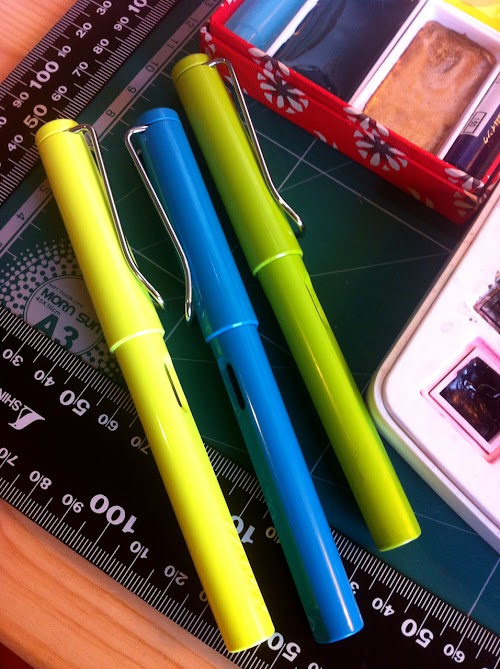
Qn: Why are there three Lamy fountain pens? Are they the similar? Beside the colour, of course.
I do picture mind-map a lot when I want to structure my (messy) thoughts and I would use my LAMY pens with it.
I have a long history using LAMY pens since college time. I tried several other pens before, but I found LAMY’s weight and stroke the easiest easy to write with.
As for colours, I have purple, blue, and black ink for each pens. Hence the 3 different ones. There’s not much reason behind it beside the fact that it’s fun to draw in multicolour. I wish LAMY would have brown ink though. I tried mixing LAMY ink colours together by myself, but it didn’t come that nice.
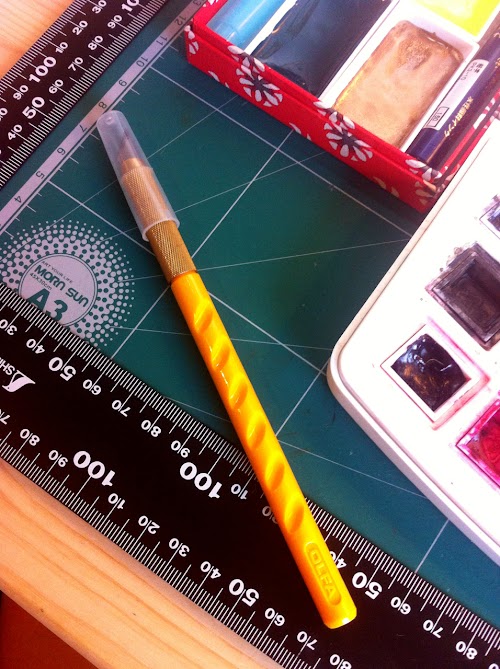

Qn: What's this palette called? Where did you get it? What brand of watercolours are these? What are the colours? Especially the bottom right one.
The first watercolour palette is called “Kuretake Gansai”, Japanese brand of watercolour palette. It’s a gift from my Japanese friend.
I love the fact that the texture of the colour is so smooth and the set came with gold colour too (the bottom right one). Other colours are basic hues - red yellow blue plus brown and green. I think this brand have more colour variety in bigger set, but I have never tried that yet.
Qn: What are the two pens by the side?
The side pens are black line marker and water brush, which I rarely use actually. They just came with the set.

The second one is Royal Talens Van Gogh. I love that they have many colours I can work with, but I prefer my own selection of colours. So after using some of them up, I replaced some other colours from tubes.
I would take the Kuretake one out with me on the day I want to travel light and use the Royal Talens Van Gogh at my studio or in the situation that I do some serious paintings than quick sketches. I also love the fact that both of these palettes give strong vibrant colours.
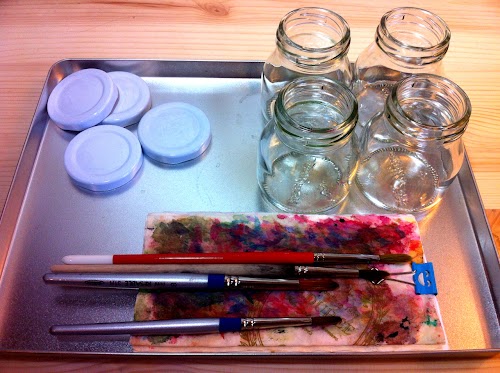
At my studio, I use glass (Hokkaido Morimoto) yogurt bottle as water buckets for I would get 1 everyday from my breakfast.
I always fill up 2 or more water bottles when I paint. One for brush cleaning, one for diluting colours, the other one for soaking brushes (especially the ones I use with black ink - you know how nasty black ink could stick to your brush) while I just can’t be bother to wash them properly yet.
Below is the picture of how I DIY my bottle for the purpose.
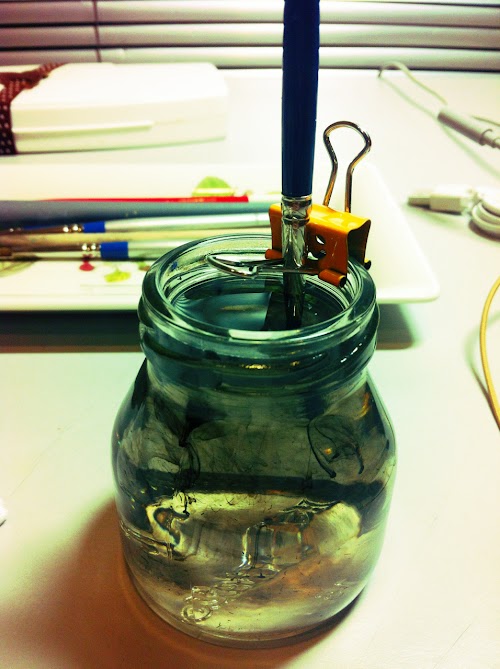

Qn: Can you give us a rundown of the brushes you use?
My watercolour and ink brushes.
- 1. Royal Talens Van Gogh no.191/6 selected filament (came with watercolour palette). The hair is made from polyester which gives more flexibility. I use this with black ink only.
- 2. Royal Talens GWVR Van Gogh Visual brush no. 6. It’s a mix between goat hair, ox hair, and nylon. The brush is softer than the previous one. I use this with watercolour for softer smudge effect.
- 3. The same as no. 1. But I use this one only for watercolour. *note if you mix black ink brush with watercolour brush, the black ink could dull your vibrance.
- 4-5. Holbien Resable 31R mini no.8 and no. 6. Shorter brushes for going out.
- 6-7. Raphael 8204 KAERELL no. 4 and no.2. These are hobby brushes actually. But I love that they are not too soft. I use these mainly for calligraphy.

Qn: What are these brushes?
LeFranc & Bourgeois polyamide brushes for acrylic painting.

Qn: What is this brush used for?
This is my old paint-area sweeping brush. I have been using this for 20 years now.

Qn: What do you use this bottle for?
This is Extra gum bottle I use as outdoor water bucket. You will be amazed how super seal-tight it can be.

Qn: That looks like Japanese black ink. Sakura brand? Where did you find this? What's its characteristics?
This is definitely standard Japanese black ink. I got this as a gift from my friend.
Together with my brushes, they became the best waterproof marker ever. I divided only small amount of the ink into tiny glass bottle when I use. I rarely dilute it with water for the stronger marker effect.

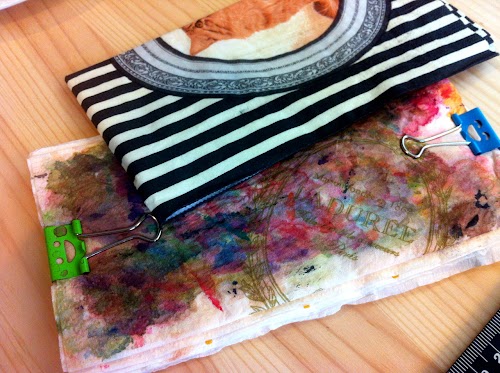
Qn: Those clips are too cute! Painted animal faces, and smiley faces! Where did you buy them?
I found these cute clips in local stationery. They are so multi-purposely useful. I use them to DIY my tools, prevent my tissue papers from flying away when I do outdoor painting in windy places, also hold thick papers together while glue is still wet, etc.
Qn: What's that black and white stripe thing?
Just some fancy tissue papers lol.

Qn: So what do you use the Scotch double sided tape for?
Sometimes I do pop-up and 3-dimensional arts as well. This double sided tape is so useful for making mock-ups. A lot cleaner than glue.

Qn: Louvre Acrylic paint. So you use Acrylic as well? These tubes look very new. Just bought them?
Yeah, they had a sale in local shop. lol. I use both acrylic and watercolour for different purposes.
Qn: What's with the big tubes Titanium White and Flesh Tint?
Yes, I use white and flesh tint a lot. Other than that, I will just mix my own palette from basic tubes.
Qn: What paper do you paint on using the Acrylic?
Anything with smooth surface. Most of the time I use ARCHES hot pressed.
Qn: Which do you prefer, acrylic or watercolours? Why? When do you use them?
Watercolour work can be fast and spontaneous. It’s like playing with how water flows and get absorbed on paper. We need to know when to keep going, when to wait. But once we mess up, there’s not much chance of fixing. We will just need to keep going and see how the outcome will surprise us.
Acrylic work is more solid. It gives more time to breath and think while painting. When I paint with watercolour, sometimes the pace is so fast that I don’t have time for deep consideration. But with acrylics, it gives me time to delicately go into details as well as more chance to create my new colour scheme and experiment with it.
To decide which is the better medium really depends on time and result I would like to achieve as well as materials we paint on. If it’s a big mural on brick wall, or painting on some wood panels, then watercolour might not stick. Once I was asked to do a wall painting when I only have watercolour available though. It still worked, but gave out different effects. So I guess there’s no rules on which is better. Just play around and see how it goes.

Qn: Why do you use baking paper?
For acrylic painting, the proper acrylic pad can be pricy. I found the non-stick baking paper a lot cheaper and could do the job. We can just throw them away afterward without taking time to scrub off paint stains.

Qn: What are these for? How do you use them? I see that they are Japanese brand also. Where did you buy them?
The left one is the brush cleaner for acrylic. Once the colour dries, it’s not water soluble anymore and become super difficult to clean. If we don’t clean the brushes well, there might be some lumps of left over colour that could ruin brush shape.
The middle and the right ones are flow palette wetting spray and flow medium. Basically they help making acrylic paint dry slower. Hence more flow when drawing lines or continuous strokes. The middle one is a spray that you spray onto the palette before mixing colours. The right one is for dropping into colours while mixing. They work similarly to me.

Qn: On what kind of artworks do you use these fixative for? So far the tools you showed me are paint tools, the Winsor Newton fixative on the left is for pastel, charcoal and pencils.
Oh I forgot to mention that I do pastels too sometimes lol. So yes, the spray is for coating the pastel painting after it’s done. The right one is the spray for watercolour and acrylic gouache. It makes the painting more vibrant as well.

Qn: That's quite an interesting book stand you have. It looks like someone is reading the book on the wrong side. Haha. Is that a handmade watercolour sketchbook? Did you make it yourself? The pages look torn. And there's a butterfly in the middle? How did you get that to stick?
You know by now that I adapt whatever available on my table for any purpose I want. Somehow this Peko chan doll is suitable for the book stand job. lol.
As for the book, it’s the handmade book I found in a shop. It’s made of traditional Japanese handmade papers therefore the rims are uneven like that. The butterfly, I tore it out from another piece of paper from the same notebook and glue it with my magic double sided tape.
Qn. So what's your favourite drawing medium? Why?
My most favourite drawing medium would be my brushes with either watercolour or black ink on whatever surface I feel like painting on.
I love using brushes to the point that I prefer them to pencils. I even write down my notes with brushes sometimes lol. You know that I don’t even sketch before I paint, right? Honestly I can’t be bother to draw twice with pencil then brush. I love how I could just dip my brush and go. It feels more fresh and spontaneous. I can also have fine or thick lines as I go along with out changing tools.

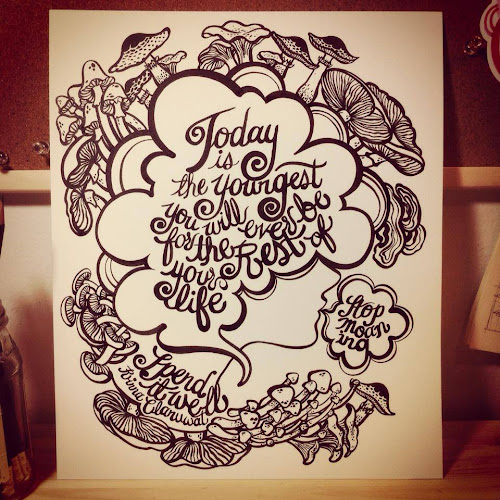
Qn: Do you use any other sketchbooks for drawing? If so, what do you use?
I used to paint a lot on Moleskine watercolour books in different sizes. But also love to collect different types of notebooks with paper that is ok with watercolour or ink. If I found sketch books l like, I would buy few of them to paint on as a collection for a while. Then I would look for different ones for a change.
Qn: Say you have $120 USD budget to buy some art materials. How would you spend it?
Hmmm…
1. Royal Talens or Rapahel or LeFranc & Bourgeois hobby (polyester) brush in no. 2, 4, 6, 8.
2. Normal black ink
3. Middle or upper brand of few basic watercolour hues (red yellow blue green purple brown black)
4. 2 bottles of Extra gum
5. Cheap plastic colour tray
6. Some smooth surface papers
I will also ask for free napkins from any cafe later and I think I’m good to go :)
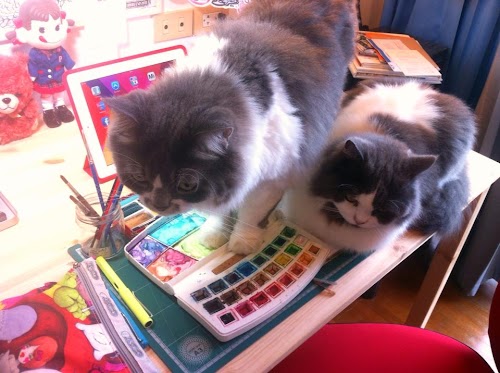
Qn: Nice cats. Seems like tabletops are one of the favourite hangout spots for cats. What are their names?
Ha ha they are 2 out of 10 cats I have. They are Dimi and Jamie :)
Qn: Do those cat get in the way of you painting? Have they even gotten paint onto themselves?
Oh yes, most of the time they would love to see how I’m doing and sometimes helping me painting by walking across my work with those fluffy paws dipped into colours from my palette. Sometimes we get nice outcome from our collaboration ;)



You can see more artworks from Rinna Clanuwat on her facebook, website and flickr.
Also check out other artist interviewees at https://www.parkablogs.com/tags/art-tools-and-gears



